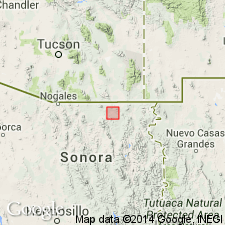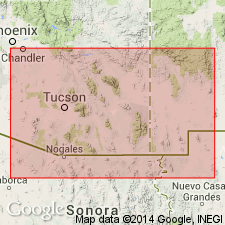
- Usage in publication:
-
- Cabullona group
- Modifications:
-
- Named
- Biostratigraphic dating
- Overview
- Dominant lithology:
-
- Conglomerate
- Sandstone
- Shale
- Tuff
- AAPG geologic province:
-
- Cabullona basin
Summary:
Named as group from its occurrence in the valley of Cabullona Creek, west of Cabullona, northeastern Sonora, Mexico. Is divided into five new formations (ascending): Snake Ridge formation, Camas sandstone, Packard shale, Upper Red Beds, and Rhyolite tuff. Component units mapped in study area. Unconformably overlies Mural limestone of Bisbee group (Lower Cretaceous). [Thickness may exceed 7,920 ft.] Vertebrate, invertebrate, and plant fossils (especially silicified tree trunks) noted. Beds deposited in littoral zone, shallow neritic zone, fresh-water lakes and swamps, and on low land adjacent to coast. Age is Late Cretaceous (probably Senonian) on basis of dinosaur remains (TRACHODON) from upper part of Snake Ridge formation.
Source: GNU records (USGS DDS-6; Denver GNULEX).

- Usage in publication:
-
- Cabullona Group*
- Modifications:
-
- Overview
- AAPG geologic province:
-
- Cabullona basin
Summary:
Is divided into five conformable formations: Snake Ridge Formation, Camas Sandstone, Packard Shales, a unit informally called the upper red beds, and an unnamed rhyolite tuff (following Taliaferro, 1933). Part or all probably equivalent to Fort Crittenden Formation (Campanian). Unnamed rocks at top considered correlative with rhyolitic tuffs of Salero Formation (Campanian and Maestrichtrian). Is interpreted that Cabullona and Fort Crittenden were once coextensive. Is largely of fluvial origin, containing fossils of brackish-water invertebrates suggestive of an estuarine environment. Late Cretaceous age of Cabullona based on dinosaur bones and lithologic similarities to Fort Crittenden and Salero Formations.
Source: GNU records (USGS DDS-6; Denver GNULEX).
For more information, please contact Nancy Stamm, Geologic Names Committee Secretary.
Asterisk (*) indicates published by U.S. Geological Survey authors.
"No current usage" (†) implies that a name has been abandoned or has fallen into disuse. Former usage and, if known, replacement name given in parentheses ( ).
Slash (/) indicates name conflicts with nomenclatural guidelines (CSN, 1933; ACSN, 1961, 1970; NACSN, 1983, 2005, 2021). May be explained within brackets ([ ]).

